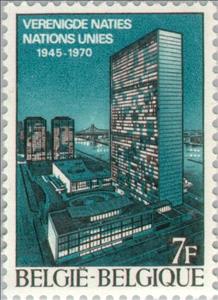Stamp: U.N.O. (Belgium 1970)
U.N.O. (Belgium 1970)
01 January (Belgium ) within release 50 years Joining of Eupen, Malmedy and St-Vith goes into circulation Stamp U.N.O. face value 7 Belgian franc
| Stamp U.N.O. in catalogues | |
|---|---|
| Michel: | Mi:BE 1602 |
| Belgium: | Bel:BE 1549 |
Stamp is vertical format.
Also in the issue 50 years Joining of Eupen, Malmedy and St-Vith:
- Stamp - COOP face value 7;
- Stamp - Virton face value 2.50;
- Stamp - Zelzate face value 2.50;
- Stamp - Nijvel face value 1.50;
- Stamp - U.N.O. face value 7;
- Stamp - 50 years Joining of Eupen, Malmedy and St-Vith face value 7;
Stamp U.N.O. it reflects the thematic directions:
An office is a space where the employees of an organization perform administrative work in order to support and realize the various goals of the organization. The word "office" may also denote a position within an organization with specific duties attached to it (see officer or official); the latter is an earlier usage, as "office" originally referred to the location of one's duty. In its adjective form, the term "office" may refer to business-related tasks. In law, a company or organization has offices in any place where it has an official presence, even if that presence consists of a storage silo, for example, instead of a more traditional establishment with a desk and chair. An office is also an architectural and design phenomenon, including small offices, such as a bench in the corner of a small business or a room in someone's home (see small office/home office), entire floors of buildings, and massive buildings dedicated entirely to one company. In modern terms, an office is usually the location where white-collar workers carry out their functions.
A bridge is a structure built to span physical obstacles without closing the way underneath such as a body of water, valley, or road, for the purpose of providing passage over the obstacle. There are many different designs that each serve a particular purpose and apply to different situations. Designs of bridges vary depending on the function of the bridge, the nature of the terrain where the bridge is constructed and anchored, the material used to make it, and the funds available to build it.
A building or edifice is a structure with a roof and walls standing more or less permanently in one place, such as a house or factory. Buildings come in a variety of sizes, shapes and functions, and have been adapted throughout history for a wide number of factors, from building materials available, to weather conditions, to land prices, ground conditions, specific uses and aesthetic reasons. Buildings serve several needs of society – primarily as shelter from weather, security, living space, privacy, to store belongings, and to comfortably live and work. A building as a shelter represents a physical division of the human habitat (a place of comfort and safety) and the outside (a place that at times may be harsh and harmful).
An anniversary is the date on which an event took place or an institution was founded in a previous year, and may also refer to the commemoration or celebration of that event. For example, the first event is the initial occurrence or, if planned, the inaugural of the event. One year later would be the first anniversary of that event. The word was first used for Catholic feasts to commemorate saints. Most countries celebrate national anniversaries, typically called national days. These could be the date of independence of the nation or the adoption of a new constitution or form of government. The important dates in a sitting monarch's reign may also be commemorated, an event often referred to as a "Jubilee".




